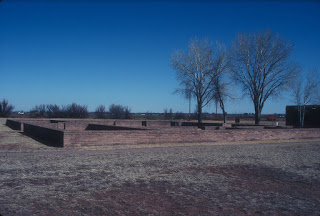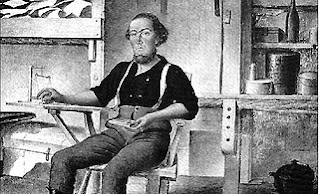Places: Fort Sumner, New Mexico and Bosque Redondo
This military post in what is now Fort Sumner, De Baca County, New Mexico is famous or infamous for many things, including the Lincoln County War and the exploits of Billy the Kid and Pat Garrett, but the most terrible thing that happened there was the internment of thousands of Navajo and Mescalero men, women and children between 1864-1866. Known in Navajo history as the Long Walk, the 300 mile trek from their homeland in Arizona to New Mexico is still seared into Navajo memory.
In 1862, Congress authorized the creation of a military fort on the banks of the Pecos River to deal with the Confederate threat from Texas as well as raids by various tribes. Soon after construction of the Fort, Gen. James H. Carleton authorized the creation of an Indian Reservation at Bosque Redondo or Round Wood. Bosque is the Spanish word for a wooded river-bottom. Carleton conceived the idea of housing both Navajo and Mescalero Apaches on the same reservation, oblivious to the fact that the two tribes were mortal enemies. To coerce the Navajo to leave their homeland in Arizona, Carleton turned to Christopher "Kit" Carson, a noted guide, mountain man and Indian Fighter. Unable to persuade the Navajo to relocate, he resorted to scorched earth tactics, burning homes and fields and destroying livestock. The Navajos were taken captive in groups and sent on the trek to Bosque Redondo. Over 50 groups made their way on a trail of tears and death. Malnourished, unprepared to move, with scant rations and no shelter, soldiers kept the columns moving. Many families have stories of grandparents who dropped dying on the trail, who had to be abandoned, or mothers in labor who were also left behind when they couldn't walk and give birth at the same time, as the soldiers seemed to expect.
Once at Bosque, families huddled in makeshift shelters. As usual with such forced migrations, the promised military rations were few and far between. Nor was medical care available. There was little firewood and the water was unhealthy. Disease and starvation was rampant. The Mescaleros ran away en masse. Many Navajo escaped from the trail or from Bosque itself and returned to hide in their homeland until better times. Others put aside their dislike of the Apache and joined the guerrilla bands who were harrying the Army. Finally, in 1868, the Army realized that this experiment in hell wasn't working and agreed to allow the Navajo to return home in the Treaty of Bosque Redondo.
Fort Sumner was abandoned and the land sold to cattle baron Lucien Maxwell. Maxwell built the officers' quarters into a mansion and it was there that Pat Garrett shot Billy the Kid. In 1968, one hundred years after the Treaty of Bosque Redondo, Fort Sumner was declared a state historical monument. A museum dedicated to the tragedy of Bosque Redondo is on site, along with the outline of the fort's ruins.
In 1862, Congress authorized the creation of a military fort on the banks of the Pecos River to deal with the Confederate threat from Texas as well as raids by various tribes. Soon after construction of the Fort, Gen. James H. Carleton authorized the creation of an Indian Reservation at Bosque Redondo or Round Wood. Bosque is the Spanish word for a wooded river-bottom. Carleton conceived the idea of housing both Navajo and Mescalero Apaches on the same reservation, oblivious to the fact that the two tribes were mortal enemies. To coerce the Navajo to leave their homeland in Arizona, Carleton turned to Christopher "Kit" Carson, a noted guide, mountain man and Indian Fighter. Unable to persuade the Navajo to relocate, he resorted to scorched earth tactics, burning homes and fields and destroying livestock. The Navajos were taken captive in groups and sent on the trek to Bosque Redondo. Over 50 groups made their way on a trail of tears and death. Malnourished, unprepared to move, with scant rations and no shelter, soldiers kept the columns moving. Many families have stories of grandparents who dropped dying on the trail, who had to be abandoned, or mothers in labor who were also left behind when they couldn't walk and give birth at the same time, as the soldiers seemed to expect.
Once at Bosque, families huddled in makeshift shelters. As usual with such forced migrations, the promised military rations were few and far between. Nor was medical care available. There was little firewood and the water was unhealthy. Disease and starvation was rampant. The Mescaleros ran away en masse. Many Navajo escaped from the trail or from Bosque itself and returned to hide in their homeland until better times. Others put aside their dislike of the Apache and joined the guerrilla bands who were harrying the Army. Finally, in 1868, the Army realized that this experiment in hell wasn't working and agreed to allow the Navajo to return home in the Treaty of Bosque Redondo.
Fort Sumner was abandoned and the land sold to cattle baron Lucien Maxwell. Maxwell built the officers' quarters into a mansion and it was there that Pat Garrett shot Billy the Kid. In 1968, one hundred years after the Treaty of Bosque Redondo, Fort Sumner was declared a state historical monument. A museum dedicated to the tragedy of Bosque Redondo is on site, along with the outline of the fort's ruins.




Comments
Post a Comment